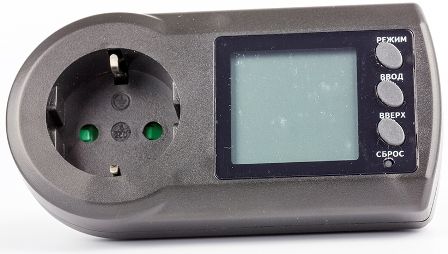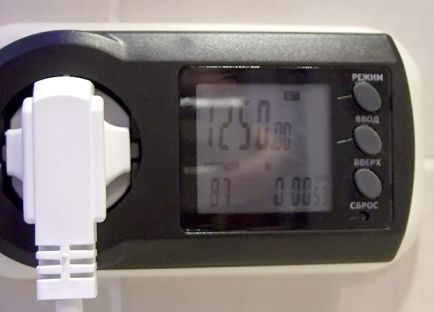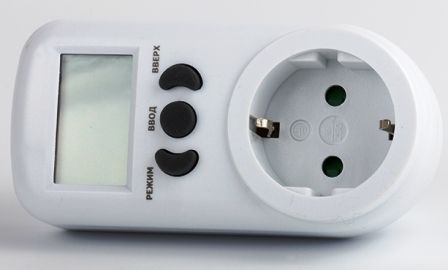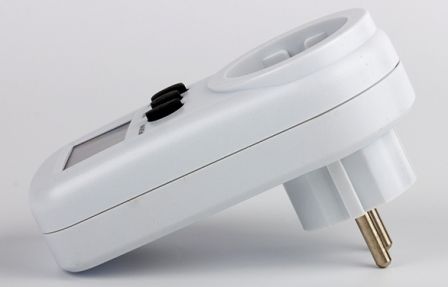Categories: Featured Articles » Interesting electrical news
Number of views: 67176
Comments on the article: 12
ROBITON PM - electricity meter in every outlet!
 Absolutely wonderful appliances. These are outlet electricity meters or household wattmeters ROBITON RM-1, RM-2. Unique instruments allow you to measure with high accuracy the amount and cost of electricity consumed, the power of the connected load, and the PM-2 also measures the voltage and frequency of the mains, the current consumed by the load and power, and takes into account the two-tariff day-night payment system. At the same time, the price of devices is such that it makes them affordable for any home.
Absolutely wonderful appliances. These are outlet electricity meters or household wattmeters ROBITON RM-1, RM-2. Unique instruments allow you to measure with high accuracy the amount and cost of electricity consumed, the power of the connected load, and the PM-2 also measures the voltage and frequency of the mains, the current consumed by the load and power, and takes into account the two-tariff day-night payment system. At the same time, the price of devices is such that it makes them affordable for any home.
However, first things first!
Energy meter - ROBITON PM-2 wattmeter Designed to measure electricity consumption by household appliances. In PM-2, you can enter the price of kilowatt hours and find out the total cost of electricity consumed by the connected electrical appliance, for example, for a month.
Since two price modes are implemented (there is a setting of days of the week and time of regime change), this model is suitable for round-the-clock measurement of energy consumption of household appliances.
For example, I connected an Ariston electric instantaneous water heater to RM-2, which has two heating elements of 1.25 kW each, in order to know how much electricity is consumed by hot water.
New knowledge has helped to take a fresh look at this issue. And the temperature on the Ariston thermostat is now set based on the real needs for hot water. You need to take a shower - we heat the water to 50 - 60 degrees. This is enough. And 40 degrees is enough for washing hands.
The function of measuring voltage is useful in the house, since it can be either high or low.
The PM-2 power meter is equipped with a large single-color LCD display, three control buttons and a “reset” button for quick data cleaning.
Displayed parameters: time, network voltage, current and power consumed by the appliance, amount of consumed electricity (kW * h), AC frequency (Hz), efficiency of the connected device (power factor), total operating time and cost of consumed electricity.

Specifications:
Supply voltage: 220V, 50Hz
Maximum current, power: 16A, 3600W
Measured Voltage Range: 190-276 VAC
Voltage Accuracy: +/- 1%
Measuring Current Range: 0.01 - 16A
Current measurement accuracy: +/- 1% or +/- 0.01A Load power range: 0.2 - 4416 W
Accuracy of measurement of load power: +/- 1% or +/- 0.2W
Total power consumption: 0.00-9999.99 kWh
Frequency measurement range: 45-65Hz
Clock Accuracy: +/- 1 minute per month
Own consumption (no load): less than 0.5W
Operating temperature: 0 ° C to + 50ºC
Batteries: 3x1.5V LR44 / AG13 Saving settings and data without connecting to a network: 3 months.

Electricity consumption meter - wattmeter ROBITON PM-1 is the younger brother of the PM-2 device. It is smaller in size. The device allows you to set the price of kilowatt hours and calculate the cost of electricity used by electrical appliances.
PM-1 is suitable only for single tariff metering. The PM-1 wattmeter is equipped with a small LCD display and three control buttons.
Displayed parameters: power of connected load, quantity of consumed kW / h, total cost of consumed electricity and price of one kW / hour.
The device is simple and convenient.


Specifications:
Input: 220V, 50Hz Max. load: 16A, 3.68 kW
Minimum displayed power: 0.1W
Measurement Accuracy: +/- 1% or +/- 0.1W (0-100W); +/- 1% (100-3600W)
Accuracy of calculation of total energy consumption: +/- 1%
Minimum displayed power consumption: 0.01kW / h
Total power consumption display: 0.00-9999.99 kWh
Price per kW / h: 0.00-9999
Own power consumption: less than 0.5W
Operating Temperature: 5 ° C to + 40 ° C
The ROBITON PM-1 power meter is conveniently used to control the power consumption of various household appliances, such as heating devices in rooms, a kettle, a washing machine, a heated towel rail, etc. The device is the smallest and the cheapest of the line. Its cost today is 798 rubles.
Why do we need these devices if every house has a regular electricity meter?
To select the optimal mode of operation of specific electrical appliances in the house to pay less money for electricity. To know the actual consumption of the appliance, which often differs from the one declared by the manufacturer (my BOSCH kettle with the claimed 1.6 kW eats more than 1.8 kW).

Especially relevant is a wattmeter with a counter in country houses and cottages where there is no gas heating and hot water supply.
For example, in my country house a power meter showed that convectors in the entrance group (entrance to the house) and in the utility rooms consume "excess" electricity. A decrease in the temperature they maintained by only 2 degrees gave tangible savings in money.
In the same way, the optimal operating mode of the storage water heater and the washing machine was chosen.
You can, of course, buy one PM-2 device and measure the network parameters and equipment consumption with it. But, if measurement at once of all parameters of the power supply network is not required, it is better to have several wattmeters, with energy-intensive electrical appliances constantly connected to them.
This will allow you to control and adjust energy consumption and rationally spend money on electricity. Indeed, if you see clearly where the money is flowing, you are unlikely to turn on the water heater 80 degrees to wash your hands several times a day in warm water.
Curious to know the power consumption of computer equipment and a TV. So I found out that my laptop, when turned on, consumes about 20 watts. However, during on / off, its power consumption increases to 80 watts. The power consumption of the computer is also increasing in resource-intensive programs, such as photo-video editors.
Every zealous or simply curious owner of a wattmeter will like it!
But, on this the use of a home wattmeter is not exhausted. A wattmeter will provide very important assistance in cases where the electric power allocated to the house is limited.
A wattmeter will help to measure the real energy consumption of energy-intensive home appliances in different operating modes. This is necessary in order to know how much and what can be turned on at the same time, so as not to cause network congestion and disconnection of the input machine.
With insufficient allocated power, it is convenient to use network load optimizer OEL-820. In this case, the wattmeter will help to distribute the load between the OEL-820 units to minimize the total power consumed by the household.
Rating:
+ functionality, simplicity, low cost, child protection (curtains)
- small size of numbers on the display.
See also at bgv.electricianexp.com
:

